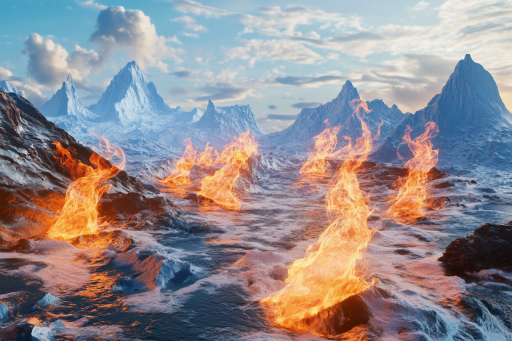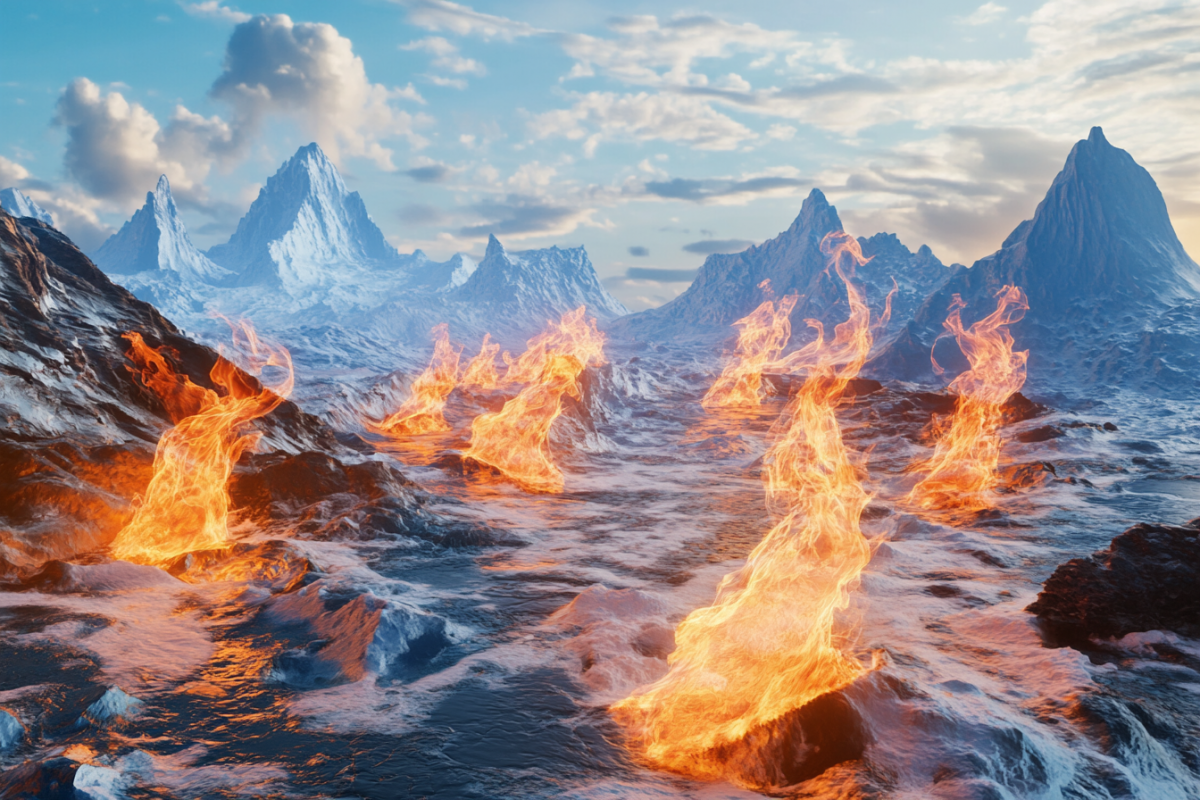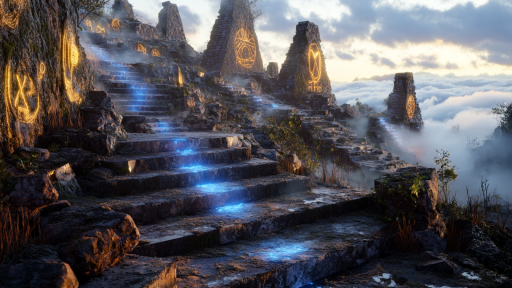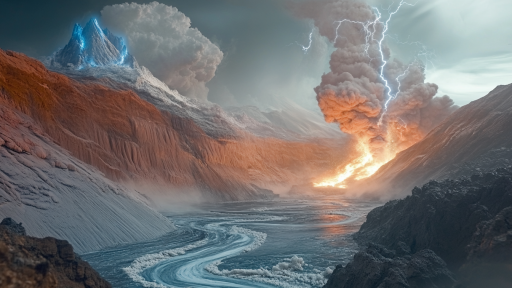
Across the world, fire defies logic, burning endlessly without a visible source of fuel. Some of these flames have been burning for centuries, fueled by natural gas leaks, chemical reactions, or mysterious geological phenomena. Whether rooted in science or surrounded by legend, these ever-burning fires continue to captivate and perplex those who witness them. What keeps them alive, and how long will they continue to burn?
The Gates of Hell – A Flaming Crater in the Desert

Deep in Turkmenistan’s Karakum Desert, a massive crater known as the “Gates of Hell” has been burning for decades. Originally created by a failed Soviet drilling operation, the pit was set ablaze in an attempt to burn off escaping gas—but it never stopped. The glowing inferno stretches over 200 feet wide, lighting up the barren landscape with its eerie, unrelenting flames. Despite efforts to extinguish it, the fiery pit continues to burn, drawing curious travelers from around the world.
Mount Wingen – Australia’s Eternal Fire

Beneath the surface of Mount Wingen, also known as the “Burning Mountain,” a coal seam fire has been smoldering for thousands of years. This underground blaze moves at a slow pace, consuming coal deposits deep beneath the earth. The only visible signs of this never-ending fire are occasional plumes of smoke and areas of scorched, cracked ground. Scientists estimate that this could be one of the longest-burning fires on Earth, yet its exact age remains unknown.
Yanar Dag – The Fire Mountain of Azerbaijan

On the Absheron Peninsula of Azerbaijan, a hillside burns continuously, with flames leaping several feet into the air. Yanar Dag, or “Burning Mountain,” is fed by underground natural gas seeping through the earth’s surface. According to legend, a shepherd accidentally set the hill ablaze centuries ago, and it has never gone out since. The flames dance hypnotically, even during heavy rain and snowfall, creating a mesmerizing display of nature’s power.
The Eternal Flame Falls – A Fire Hidden Behind a Waterfall

In New York’s Chestnut Ridge Park, a small but steady flame flickers behind a cascading waterfall. This unusual phenomenon, known as the Eternal Flame Falls, is caused by natural gas escaping from underground fissures. The contrast between the rushing water and the persistent flame creates an almost magical sight. Though the flame can occasionally be extinguished by strong winds or water flow, it is easily reignited, continuing its cycle of endless burning.
The Baba Gurgur – Iraq’s Never-Ending Flame

Near the city of Kirkuk, a massive gas field known as Baba Gurgur has been burning for thousands of years. Revered in ancient times, this “Father of Eternal Fire” was even mentioned in historical texts as a sacred place. The flames emerge from a natural gas seep, creating an ever-present blaze that was once used as a landmark for travelers. Locals still tell stories of how its fire has guided people through the harsh desert for generations.
The Centralia Mine Fire – A Town Consumed by Flames

What began as a simple coal mine fire in the town of Centralia, Pennsylvania, turned into a disaster that still burns underground today. Ignited in the 1960s, the fire spread through coal seams beneath the town, forcing residents to evacuate as roads cracked and toxic fumes filled the air. Decades later, steam and smoke still rise from the ground, creating an eerie post-apocalyptic landscape. Centralia remains a ghost town, with the underground fire continuing to burn unchecked.
Jharia Coal Fields – India’s Inferno Below

Beneath the town of Jharia in eastern India, coal fires have been raging underground for over a century. These fires have devastated the land, forcing entire communities to relocate as buildings collapse and the ground gives way to flames. Despite efforts to control the blaze, it continues to spread, threatening lives and livelihoods. The smoky air and glowing fissures in the ground serve as a constant reminder of this ongoing disaster.
Chimaera Flames – Turkey’s Ever-Burning Rocks

Atop Mount Chimaera in Turkey, flames spontaneously emerge from rocky crevices, burning bright against the night sky. These natural gas fires have been burning for centuries, inspiring legends of fire-breathing creatures from ancient mythology. Sailors once used the flames as a natural lighthouse, guiding their way along the coast. Even today, visitors can witness the eternal flames flickering against the rugged mountainside.
Smoking Hills – Canada’s Fiery Coastline

Along Canada’s Arctic coastline, the Smoking Hills have been burning for centuries due to naturally occurring oil shale deposits. As the mineral-rich rocks oxidize and combust, they release continuous plumes of thick smoke, creating a surreal and alien-like landscape. This unusual geological phenomenon has been documented for centuries and remains one of the most remote burning sites on Earth. Even in the frigid Arctic conditions, the flames persist, shaping the rugged landscape.
The Brennender Berg – Germany’s Burning Mountain

A coal seam fire has been smoldering beneath the Brennender Berg (“Burning Mountain”) in Germany for hundreds of years. First documented in the 17th century, the fire continues to burn underground, occasionally venting through cracks in the rocky hillside. The landscape above appears deceptively calm, yet wisps of smoke escaping from fissures hint at the inferno below. Even Goethe wrote about this fiery enigma, adding to its historical intrigue.
Mordor of Java – Indonesia’s Ijen Crater

At the Ijen Crater in Indonesia, an extraordinary blue fire burns due to ignited sulfuric gases escaping from deep underground. Unlike other eternal flames, this phenomenon is only visible at night, creating an otherworldly glow. The intense heat causes sulfur to ignite spontaneously, forming eerie electric-blue flames. The surreal, almost alien landscape makes this one of the most visually stunning eternal fires on Earth.
Fire Without End – What Fuels the Unstoppable?

These burning places defy expectations, challenging our understanding of fire and the forces that sustain it. Some have become landmarks, drawing curious travelers, while others have led to devastation and abandonment. Whether fueled by science, myth, or mystery, these unrelenting flames continue to burn, reminding us that Earth still holds many untamed wonders. How many more fires lie undiscovered, waiting to be found?





